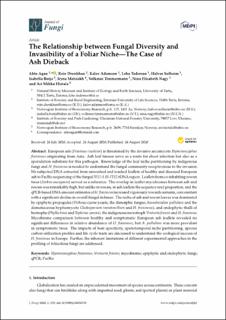| dc.contributor.author | Agan, Ahto | |
| dc.contributor.author | Drenkhan, Rein | |
| dc.contributor.author | Adamson, Kalev | |
| dc.contributor.author | Tedersoo, Leho | |
| dc.contributor.author | Solheim, Halvor | |
| dc.contributor.author | Børja, Isabella | |
| dc.contributor.author | Matsiakh, Iryna | |
| dc.contributor.author | Timmermann, Volkmar | |
| dc.contributor.author | Nagy, Nina Elisabeth | |
| dc.contributor.author | Hietala, Ari Mikko | |
| dc.date.accessioned | 2021-01-26T15:32:27Z | |
| dc.date.available | 2021-01-26T15:32:27Z | |
| dc.date.created | 2020-10-22T23:51:15Z | |
| dc.date.issued | 2020-08-26 | |
| dc.identifier.citation | Journal of fungi (JoF). 2020, 6 (3), . | en_US |
| dc.identifier.issn | 2309-608X | |
| dc.identifier.uri | https://hdl.handle.net/11250/2724843 | |
| dc.description.abstract | European ash (Fraxinus excelsior) is threatened by the invasive ascomycete Hymenoscyphus fraxineus originating from Asia. Ash leaf tissues serve as a route for shoot infection but also as a sporulation substrate for this pathogen. Knowledge of the leaf niche partitioning by indigenous fungi and H. fraxineus is needed to understand the fungal community receptiveness to the invasion. We subjected DNA extracted from unwashed and washed leaflets of healthy and diseased European ash to PacBio sequencing of the fungal ITS1-5.8S-ITS2 rDNA region. Leaflets from co-inhabiting rowan trees (Sorbus aucuparia) served as a reference. The overlap in leaflet mycobiomes between ash and rowan was remarkably high, but unlike in rowan, in ash leaflets the sequence read proportion, and the qPCR-based DNA amount estimates of H. fraxineus increased vigorously towards autumn, concomitant with a significant decline in overall fungal richness. The niche of ash and rowan leaves was dominated by epiphytic propagules (Vishniacozyma yeasts, the dimorphic fungus Aureobasidion pullulans and the dematiaceous hyphomycete Cladosporium ramotenellum and H. fraxineus), and endophytic thalli of biotrophs (Phyllactinia and Taphrina species), the indigenous necrotroph Venturia fraxini and H. fraxineus. Mycobiome comparison between healthy and symptomatic European ash leaflets revealed no significant differences in relative abundance of H. fraxineus, but A. pullulans was more prevalent in symptomatic trees. The impacts of host specificity, spatiotemporal niche partitioning, species carbon utilization profiles and life cycle traits are discussed to understand the ecological success of H. fraxineus in Europe. Further, the inherent limitations of different experimental approaches in the profiling of foliicolous fungi are addressed. | en_US |
| dc.language.iso | eng | en_US |
| dc.publisher | MDPI, Basel, Switzerland | en_US |
| dc.rights | Navngivelse 4.0 Internasjonal | * |
| dc.rights.uri | http://creativecommons.org/licenses/by/4.0/deed.no | * |
| dc.title | The Relationship between Fungal Diversity and Invasibility of a Foliar Niche—The Case of Ash Dieback | en_US |
| dc.type | Peer reviewed | en_US |
| dc.type | Journal article | en_US |
| dc.description.version | publishedVersion | en_US |
| dc.rights.holder | © 2020 by the authors | en_US |
| dc.source.pagenumber | 27 | en_US |
| dc.source.volume | 6 | en_US |
| dc.source.journal | Journal of fungi (JoF) | en_US |
| dc.source.issue | 3 | en_US |
| dc.identifier.doi | 10.3390/jof6030150 | |
| dc.identifier.cristin | 1841681 | |
| dc.relation.project | COST (European Cooperation in Science and Technology): FP1103 | en_US |
| dc.source.articlenumber | 150 | en_US |
| cristin.ispublished | true | |
| cristin.fulltext | original | |
| cristin.qualitycode | 1 | |

